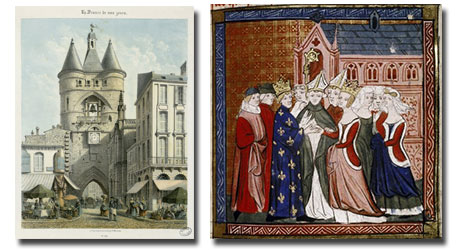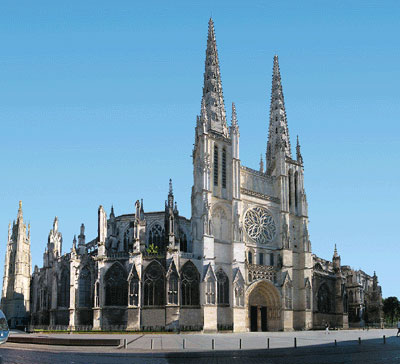There’s very little of the medieval city of Bordeaux left around here – the result of trade-fueled boom years in the 18th century when money was pouring through the port and the city planners proudly stripped out the remains of the old walled town, replacing it with the elegant limestone façades that earned it, in the early 21st century, the protection of UNESCO as a World Heritage Site.

For those of us that are looking, though, there are still a few traces, particularly if you walk out at dusk along the narrow lanes of the pedestrianised Old Town. Here you just might be able to catch a glimpse of how Bordeaux would have looked during the three centuries, from 1152 to 1453, that this south-western city was a duchy of the crown of England.
The Saint André cathedral for one, rebuilt in the 15th century but with a single wall in the nave remaining of the original building where Eleanor of Aquitaine, at just 13 years old, married her first husband King Louis VII (although not her second one that brought her to the English crown). A few streets away is the Grosse-Cloche, built in the 1400s on the remains of one of the old city gates and another reminder of the last days of a partnership that proved surprisingly endurable and profitable for both sides.
But the heart of the Anglo-Gascon administration, the Palais de L’Ombrière, has been entirely razed to the ground. This palace served as tax office, customs house and grand residence of the Sénéchal or Governor of Guyenne, and stood just inside the main entrance to the medieval city accessed through the Porte Cailhau (which still stands) on the current Place du Palais. And along with it have gone the ramparts, the maze of towers, the tiny sidestreet chapels, the gabled houses, the torturously winding lanes, the thousand and one remembrances of the dirty, teeming vibrancy of medieval Bordeaux; not least the vines that would have grown on all sides right up to the city walls.

and adapted under the Creative Commons BY-SA 3.0 Unported license.
For some of the richest images of the city during this 300-year period that marked so indelibly the Bordeaux wine trade, you have to go instead to the south bank of the river Thames in London. This is where the English national archives are held in Kew, and where you will find a collection of 144 parchment scrolls, carefully scribed by hand across an assortment of tightly stretched calfskin, goatskin or sheepskin papers, that date from 1273 to 1467.
These ‘Gascon Rolls’, written in Latin by English scribes at the Palace of Westminster (where the House of Commons is today) were drawn up by the English royal administration, and detail Aquitaine – or Gascony as it was then – under English rule, recording a wide range of details from wine sales to granting of merchant licenses, to tax receipts and disputes over titles and lands. Among the records are lists of the many ships that sailed between Bayonne, Bordeaux and England, with descriptions of the tons of wine carried on them. The barrel owners are also listed, with usually ten to 15 different names per ship.
They are an astonishingly rich resource that I have read about, written about and taught about since arriving in Bordeaux as another English hopeful drawn by the promise of wine. But incredibly that there has never been any full transcription of their contents until now, so searching through them for specific queries would have needed a degree in Latin. That is changing through a project headed up by several English universities that dates from 2009 and is due to finish in May 2015 (‘we won’t have completed everything by then,’ one of the lead researchers Guilhem Pépin tells me, ‘but that’s when the funding runs out’).
‘Bordeaux did well financially out of its status as a duchy of England, but the fact that the union between England and Gascony lasted for 300 years would have been impossible if it was just about money,’ he adds as we sit down to coffee outside, appropriately enough, the Saint André Cathedral. ‘The Gascons did not consider themselves as French, and in many ways saw the duchy as a successful sign of independence. They had a sense of loyalty to the Plantagenet dynasty in England, and fought to keep the partnership going – sometimes doing a much better job of fighting off the French than the English forces themselves.’
The unwillingness of the region to surrender the relationship is seen through the fact that the Gascon Rolls continued for 15 years after the final battle of the Hundred Years War in Castillon in 1453. French forces retook the area and many Gascons were exiled to England – where they continued with the Rolls, clearly hoping they would be needed again. Even one century later, in 1548, the Bordelais wore the red and white English cross of Saint Georges as a sign of protest during a salt tax revolt, using as a rallying cry ‘Guyenne and St Georges!’.

By the time the English left, the system of selling Bordeaux wine through brokers and merchants was well established and would prove remarkably tenacious. Learning more about its origins is an exciting prospect, although the Gascon Rolls project is not a word-for-word translation, and involves instead the production of detailed summaries, in English, highlighting places, people, acts and kings in each document that will be searchable online. There are other documents from this period in London’s Guildhall/Corporation of London archives that record trades between Gascon and England, but these also need funding. They were partially translated in the 19th century, but not fully, and many are likely to be jumbled up with other domestic records dealing with English trades.
To date, from the Bordeaux wine trade, only Chateau Ausone has donated funds to help translate the Rolls (and been rewarded with details of a chateau-fort that stood on the site of today’s chateau just outside the city walls of Saint Emilion, destroyed probably by the city elders just before the Hundred Years War to stop it falling into French hands). Who knows what other treasures we are missing?

Columnist Introduction
Jane Anson is Bordeaux correspondent for Decanter, and has lived in the region since 2003. She is author of Bordeaux Legends, a history of the First Growth wines (October 2012 Editions de la Martiniere), the Bordeaux and Southwest France author of The Wine Opus and 1000 Great Wines That Won’t Cost A Fortune (both Dorling Kindersley, 2010 and 2011). Anson is contributing writer of the Michelin Green Guide to the Wine Regions of France (March 2010, Michelin Publications), and writes a monthly wine column for the South China Morning Post in Hong Kong, where she lived from 1994 to 1997. Accredited wine teacher at the Bordeaux Ecole du Vin, with a Masters in publishing from University College London.
Click here to read all articles by Jane Anson>>
- Follow us on Weibo @Decanter醇鉴 and Facebook
and Facebook for most recent news and updates -
for most recent news and updates -
All rights reserved by Future plc. No part of this publication may be reproduced, distributed or transmitted in any form or by any means without the prior written permission of Decanter.
Only Official Media Partners (see About us) of DecanterChina.com may republish part of the content from the site without prior permission under strict Terms & Conditions. Contact china@decanter.com to learn about how to become an Official Media Partner of DecanterChina.com.

Comments
Submit